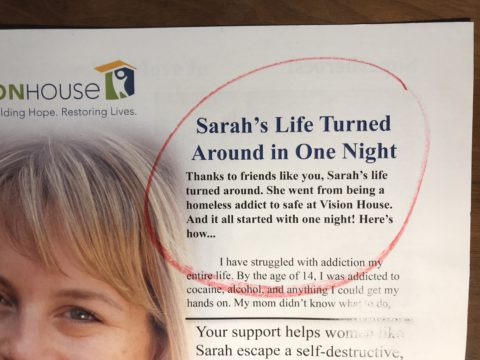The following post is one of the most popular posts in the history of this blog.
I’m reposting it because you might be new to the blog, or you might be like me and need to hear a piece of advice more than once before it really sinks in.
This post proved helpful to thousands of people, I hope it’s helpful for you!
The first sentence of every newsletter story is really important.
Don’t do what most nonprofits do. They assume that all donors read to the end of all articles. I routinely review newsletters where the most powerful parts of the stories are in the last paragraphs – where very few people will see it. Because all the eye-tracking studies show that most donors don’t “read” your newsletter. They scan it.
So, you want to work hard on the first sentence of your newsletter articles and stories. If the donor likes your first sentence, she’s more likely to read your second sentence, and so on.
And you don’t have to be a “writer” to make the first sentences of your newsletter sing. But you do have to think about them differently. I have 25 years experience that testifies that the following ‘ways of thinking differently’ about how your start your newsletter articles will help you raise more money.
Keep it simple
Make it short and easy to read. No long sentences. No complex sentences with multiple clauses. Your reader should be halfway into the second sentence before she realizes it.
Now you have momentum. Now you have a greater chance your donor is going to get the message you’re sending her.
Good Example: “Ebola took everything Elisabeth had.”
It’s not about your organization
The first sentence of any newsletter article should never be about your organization or staff.
The most successful newsletters are written with the purpose of showing your donor what her gift accomplished. Not to talk about all of the things you’ve been doing or have coming up. Because more people are reading your newsletter wondering “I wonder if my gift made a difference?” than are wondering “I wonder what the organization has been working on?”
So, your first sentence should be about the donor, or about a beneficiary.
(And remember: as your donor is deciding whether to read your story or not, she is in a hurry and has other things asking for her attention. So, if your first sentence is about your organization or staff, she’s just not as likely to keep reading.)
After all, would you be more likely to keep reading if the story was about something amazing you helped do, or something an organization you support is working on?
Bad Example: “After landing in the capital city of Kinshasa, The Democratic Republic of Congo, our team traveled inland to a village outside the town of Kivuvu.” Why would a busy donor keep reading?
Good Example: “Thanks to you, Sarah’s life turned completely around.” Bonus points for including the donor and a beneficiary in the very first sentence!
It’s the start of a summary
I need to do an entire post on writing newsletter stories. But here’s one of my tricks; the first paragraph is often a summary of the whole article.
Why? Because most people are not going to read the whole article, but you still want them to get the message you’re trying to send. So if you summarize the message in a compelling way two great things happen:
- More people get the message you’re sending
- More people will read the whole thing
Good Example: “Your gift did something simple but life changing for a mother named Teri Maes, and you might have saved the lives of her two sons.” This one is a little long, but it summarizes the whole story AND includes the donor!
Don’t start with a statistic
In a nutshell, experts love statistics. But donor’s don’t.
Experts like you, your staff, and your incredible program people love statistics. Statistics are meaningful to experts because they provide context, show progress, and show expertise.
But that’s not what most donors are looking for. They are looking for a quick, easy way to know whether their gift to your organization made a difference. That’s usually a story of a beneficiary, with a little editorial content for how the donor’s gift helped the beneficiary.
Starting with a statistic immediately reduces the number of people who will keep reading because it asks the donor to understand something new and then understand why it’s important or helpful. That’s a lot to ask of a non-expert donor who is moving fast.
She’d rather read a story, my friend. So start with a story.
Bad Example: “Only one in nine children in our great state will ever go to a symphony.”
Drama! Action! Peril!
I’m going to quote my post on appeal letters on this one:
“Fill it with drama or make it interesting to your donor. Drama and tension are two of the best tools you have for engaging their interest. Or make it something that would be interesting to your donor – which is likely something different than would be interesting to you!”
My best one-liner about this is, “You want to write like the National Inquirer, not National Geographic.” That probably over-dramatizes it, but drama and emotion catch people’s interest. Most nonprofits assume they have their donor’s interest – and that’s a bad assumption.
Bad Example: “Drs. Martha and Robert Bryant strive to use their medical practice to make an impact.” Who are those people? Why should the donor keep reading?
Good Example: “The first night Jacqueline went to community theater, her life changed in the second act.”
So as you go to work on your next newsletter, here’s what I hope you’ll remember:
- Very few people will read an entire newsletter article. So get to the point very quickly, summarize it, then tell the full scope of the story.
- To increase the chances that your donor will read more, make your first sentence easy to read and interesting to her!
This post was originally published on February 2, 2018.



